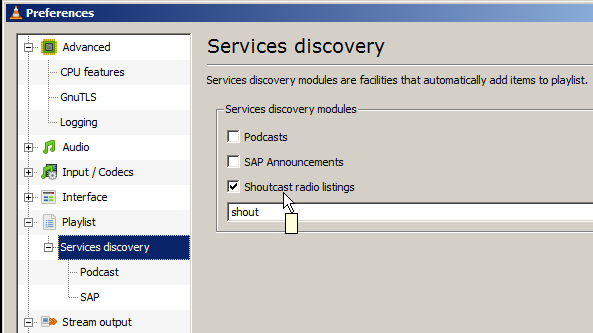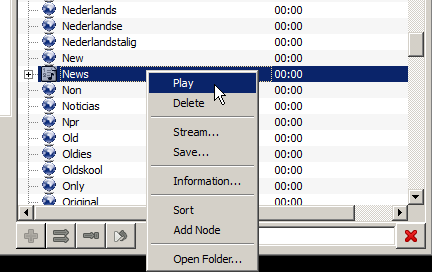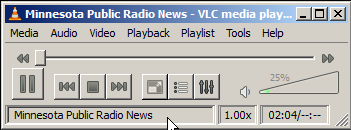Difference between revisions of "Documentation:Playlist"
(Moved from Documentation:Play HowTo/Basic Use 0.9) |
(Move part #2 from Documentation:Play HowTo/Basic Use 0.9) |
||
| Line 1: | Line 1: | ||
| − | A playlist is a customised list of media files you might want to watch or listen to. Using a playlist, you can specify the media files you want to listen each time you start the VLC media player. You can add tracks from CDs, radio stations, and movies to a playlist. | + | A playlist is a customised list of media files you might want to watch or listen to. Using a playlist, you can specify the media files you want to listen each time you start the VLC media player. You can add tracks from CDs, radio stations, and movies to a playlist. To access the playlist, click on the ''Playlist'' button in the main interface. |
==Additional Sources== | ==Additional Sources== | ||
| Line 120: | Line 120: | ||
http://www.videolan.org/doc/play-howto/en/images/play-howto/intf-osx-open-disk.jpg The Open disk dialog - MacOS X interface'''- needs verifying for 0.9''' | http://www.videolan.org/doc/play-howto/en/images/play-howto/intf-osx-open-disk.jpg The Open disk dialog - MacOS X interface'''- needs verifying for 0.9''' | ||
| + | |||
| + | |||
| + | ==Sorting== | ||
| + | |||
| + | In the wxWidgets interface, ''Sort'' allows you to sort the playlist according to several criteria, or to shuffle it. You can also sort by clicking the header of the column. | ||
| + | |||
| + | In the MacOS X interface, sorting can be done by clicking the header of the column matching the criteria you want to use for sorting. | ||
| + | |||
| + | ==Playlist modes== | ||
| + | |||
| + | The playlist supports several playback modes. | ||
| + | |||
| + | In the wxWidgets interface, the toolbar contains three playlist mode buttons. They allow to enable random mode, to repeat the whole playlist or to repeat one item. | ||
| + | |||
| + | In the MacOS X interface, random mode can be enabled by selecting the ''Random'' box. A drop down menu allows you to enable playlist and item repeat modes. | ||
| + | |||
| + | ==Misc== | ||
| + | |||
| + | ===Search=== | ||
| + | |||
| + | You also have a search tool. Enter a search string and hit search. The next item to match the string will be highlighted. Keep hitting Search to cycle between all matching items. | ||
| + | |||
| + | ===Moving items=== | ||
| + | |||
| + | In the wxWidgets interface, the ''Up'' and ''Down'' buttons at the bottom of the playlist window allow you to move an item. Select an item and use these buttons to move it. | ||
| + | |||
| + | In the MacOS X interface, you can easily move an item with the mouse, using drag-and-drop. | ||
| + | |||
| + | ===Contextual menu=== | ||
| + | |||
| + | By right-clicking or control-clicking an item, a contextual menu will appear, giving access to a number of functions (for example, play the item, disable it, delete it, or get info on it). | ||
==Play a network stream (WebRadio, WebTV, etc.)== | ==Play a network stream (WebRadio, WebTV, etc.)== | ||
Revision as of 10:53, 28 November 2010
A playlist is a customised list of media files you might want to watch or listen to. Using a playlist, you can specify the media files you want to listen each time you start the VLC media player. You can add tracks from CDs, radio stations, and movies to a playlist. To access the playlist, click on the Playlist button in the main interface.
Contents
Additional Sources
In addition to audio and video files, you can play other formats. The additional formats supported by VLC media player are described in the following sections:
- Podcasts - Podcast (Personal On Demand broadCASTING) is a series of audio or video digital media files which is distributed over the Internet and downloaded to media players. If consumers subscribe to Podcasts, whenever new content is added the content gets automatically added to the playlist.
You can customise Podcasts. To add a Podcast URL
- Select Podcast from Additional Sources in the Playlist menu.
- Select Show Playlist from the Playlist menu. The Playlist dialog box is displayed. Podcast is added in the left pane.
- Click on Podcast to select it in the left pane. The Podcast streams are added under Title in the right pane.
- Select a Podcast stream and right-click. Select Play from the popup menu.
- SAP Announcements – Helps to advertise your stream over the network. To play a SAP announcement
- Select SAP Announcement from Additional Sources in the Playlist menu.
- Select Show Playlist from the Playlist menu. The Playlist dialog box is displayed. SAP is added in the left pane.
- Click on SAP to select it in the left pane. The SAP announcements are added under Title in the right pane.
- Select an SAP announcement and right-click. Select Play from the popup menu.
- Shoutcast Radio Listings – Shoutcast is a server for streaming the media developed by Nullsoft. Digital audio content can be broadcast from and to media players, and this helps individuals to create Internet radio networks. Using VLC media player, you can listen to your favourite radio stations and you can also create bookmarks to listen to these radio stations in future. To customise a Shoutcast radio listing
- Select Shoutcast radio listing under Additional Sources in the Playlist menu.
- Select Show Playlist from the Playlist menu. The Playlist dialog box is displayed. Shoutcast Radio is added to the playlist. Shoutcast Radio is added only if you select Shoutcast radio listing from Additional Sources.
- Select the Shoutcast Radio in the left hand panel. A list of radio stations appears in the right hand panel. If nothing appears in the right hand panel try double-clicking the Shoutcast Radio option and wait. It may take a few minutes the first time. After a while, the right hand panel displays a list of titles.
- Scroll down and select a radio station.
- Right-click on a radio station and
- Select Play if you want to listen to the radio station.
- Select Delete if you want to delete the radio station.
- Select the Stream option. The Stream output dialog box is displayed. Refer to the Specifying Specifying Streaming options section for more details. Modify the required parameters and click on the Stream button to stream the media file.
- Click to select a title in the Playlist dialog box and right-click. Select Save from the popup menu. The Stream Output dialog box is displayed. Select the required options and click on the Save button in the Stream Output dialog box. Refer to the Specifying Streaming options section for more details.
- Select the Information option. The Media Information dialog box is displayed with details of the media being played.
- Select Sort to alphabetically sort the radio stations.
- Click to select a title in the Playlist dialog box and right-click. Select Open Folder from the popup menu. A folder is opened to show all sub nodes within a title.
- Select Add Node to add a node.
- Click to select a title in the Playlist dialog box and right-click. Select Information from the popup menu to view the details of the selected title. Refer to the Media Information section for more details on options.
- Shoutcast TV stream – You can watch streaming TV using the VLC media player. Shoutcast TV stream refers to a stream transmitted by Nullsoft. The procedure of customising the TV stream and the options are similar to that of the Shoutcast Radio.
- Freebox TV listing – Refers to television service over ADSL accessible by Freebox Free Zone unbundled.

Note: You should be connected to the Internet to access these streams.
Add Media Files to Playlist
You can add several media files to a playlist. The media files could be selected from the media library, additional sources, and some other source.
To add files to a playlist
- Select Show Playlist from the Playlist menu. The Open playlist file dialog box is displayed.
- Locate the media file and click on OK.
- Click on the
Add icon. A short list appears with two options: Add file and Add directory.
- Select Add file to add a file to the playlist.
- Select Add directory to add a directory containing media files to the playlist.
- Click on the
Random icon. This icon toggles between Random and Random Off. Click on
to play files at random. Click on
and the files are played in an order.
- Click on the
Repeat icon. This icon toggles between Repeat One and Repeat All. If you want to listen to a track several times, click on
icon. If you want to listen to all tracks, click on
again.
- To search for a media file, enter the name in the Search box. To search for media files with certain names or formats, enter a word or phrase in the Search box. All files with the specified name are listed.
- Click on the
icon. This icon is used to skip to the current item when you have a very long list.
- Click on the
icon to clear a track from the playlist.
Load Playlist
This option is used to add a playlist created in some other media player. You can load playlists of the .xspf, .asx, .b4s and .m3u formats. To load a playlist
- Select the Load Playlist option from the Playlist menu. The Open playlist file dialog box is displayed.
- Locate a playlist file and click on Open. The selected playlist is added in the current playlist dialog box.
Save Playlist
You can save playlists using the VLC media player in format of your choice. To save a playlist
- Create a playlist. Refer to Add Media Files to Playlist for creating a playlist.
- Select Save Playlist to File from the Playlist menu. The Choose a filename to save playlist dialog box is displayed.
- Select the created playlist.
- Select a format in which the playlist must be saved from the Files of type list. The Files of type list contains the .xspf and .m3u formats.
- Click on Save to save the playlist in the selected format.
Play a file
To play a file, open the Media menu, and select the Open File menu item. An Open File dialog box will appear. Select the file you want to open, and click Open. VLC will start playing the selected file.
An alternative is to drag 'and' drop your file onto the VLC main interface or playlist window from the file explorer (Finder on MacOS X).
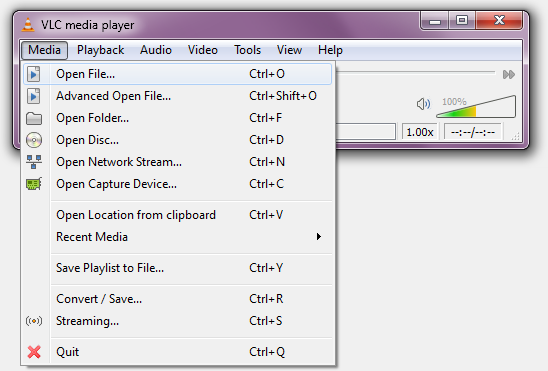
VLC 0.9.8a version Windows XP mode
 The File menu - MacOS X interface- needs verifying for 0.9
The File menu - MacOS X interface- needs verifying for 0.9
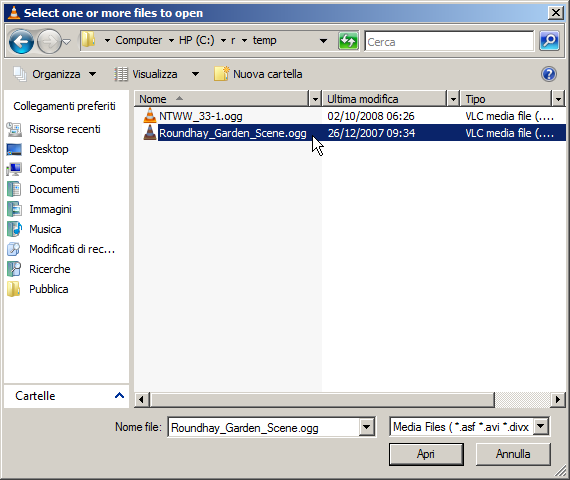 The Open file dialog - wxWidgets interface
The Open file dialog - wxWidgets interface
(need 0.9 screenshot for MacOS) The Open file dialog - MacOS X interface
Play a CD/DVD/VCD
To Play a CD, VCD or a DVD, open the File menu, and select the Open Disc... menu item. In the Open Disk Dialog Box, select the type of media (DVD, VCD or Audio CD). When reading a DVD, you can enable DVD menus by selecting the DVD (menus) disc type in the wxWidgets Interface. In the MacOS X interface, this can be done by selecting the "Use DVD menus" dialog box.
You can select the drive from which the media should be read by giving the appropriate drive letter or device name in the "Device Name" text input. This should be auto-detected on MacOS X.
If you want to start the DVD or VCD playback from a given title and chapter instead of from the beginning, you can set it using the Title and Chapter selectors.
You can start playback by selecting the Ok button.
 The Open disk dialog - wxWidgets interface- needs verifying for 0.9
The Open disk dialog - wxWidgets interface- needs verifying for 0.9
 The Open disk dialog - MacOS X interface- needs verifying for 0.9
The Open disk dialog - MacOS X interface- needs verifying for 0.9
Sorting
In the wxWidgets interface, Sort allows you to sort the playlist according to several criteria, or to shuffle it. You can also sort by clicking the header of the column.
In the MacOS X interface, sorting can be done by clicking the header of the column matching the criteria you want to use for sorting.
Playlist modes
The playlist supports several playback modes.
In the wxWidgets interface, the toolbar contains three playlist mode buttons. They allow to enable random mode, to repeat the whole playlist or to repeat one item.
In the MacOS X interface, random mode can be enabled by selecting the Random box. A drop down menu allows you to enable playlist and item repeat modes.
Misc
Search
You also have a search tool. Enter a search string and hit search. The next item to match the string will be highlighted. Keep hitting Search to cycle between all matching items.
Moving items
In the wxWidgets interface, the Up and Down buttons at the bottom of the playlist window allow you to move an item. Select an item and use these buttons to move it.
In the MacOS X interface, you can easily move an item with the mouse, using drag-and-drop.
By right-clicking or control-clicking an item, a contextual menu will appear, giving access to a number of functions (for example, play the item, disable it, delete it, or get info on it).
Play a network stream (WebRadio, WebTV, etc.)
To open a network stream, open the "Media" menu and select the "Open Network" menu item.
- To open a UDP unicast stream, select UDP/RTP, and set the appropriate UDP port in the selector (it is 1234 for streams sent by a VLC or VLS server).
- To open a UDP multicast stream, select UDP/RTP multicast. Give the address of the multicast group in the "Address" text input, and select the appropriate UDP port.
- To open a stream sent over http (Webradios, WebTVs, Shoutcast, Icecast...), ftp, or mms (Microsoft Media Server), select "HTTP/FTP/MMS", and give the corresponding complete URL, (http://www.tvcultura.com.br/radiofm/radiofm.asx) in the corresponding text input. This also the way to open a RTSP stream with the MacOS X interface.
- To open a RTSP stream (sent by Darwin Streaming Server, VLC, etc), in the wxWidgets interface, select "RTSP" and give the URL in the text input.
You can start playback by selecting the Ok button.
If you get some stuttering during playback, you can try to increase the size of the read buffer. This can be done in the Open Network Stream dialog box, by selecting the Caching box. You can then choose the amount time (in milliseconds) VLC should store data in its buffer before starting playback.
 The Open network dialog - wxWidgets interface- needs verifying for 0.9
The Open network dialog - wxWidgets interface- needs verifying for 0.9
 The Open network dialog - MacOS X interface- needs verifying for 0.9
The Open network dialog - MacOS X interface- needs verifying for 0.9
Example finding a Shoutcast radio stream
This example was verified as working on 15 October 2008, using VLC 0.9.4 under Windows Vista. This needs reproducing by other people on other versions and other operating systems.
1. Ensure your firewall is set to allow the VideoLan program to make outgoing connections.
2. Click Tools then Preferences, click Interface and then click All under "Show settings". Then click the "-" next to "Playlist" in order to show the "Services discovery" submenu. If the shoutcast radio listings box is empty, click it so that a check-mark appears. The text field underneath should now show the word "shout". Click the Save button to save and close the Preferences window:
3. Restart VLC media player to make it take notice of the changed preferences.
4. On the VLC interface click Playlist, then click Show Playlist. Select the "Shoutcast Radio" in the left hand panel. If nothing appears in the righthand panel, try double-clicking "Shoutcast Radio" and waiting, it may take a few minutes the first time. After a while the righthand panel displays a long list of titles.
5. Scroll down the radio stations in the right-hand panel and select one. Click the mouse right button and click the "Play" item.
6. It may take some time for the connection to the radio station to establish (and it may fail if the station's outgoing streams are all occupied). When it does connect, VLC should start playing the audio stream from the station:
Example playing a known Shoutcast radio stream
Go to http://www.shoutcast.com/ and search for a radio station of your choice. On Windows, right-click your mouse over Shoutcast's "Tunein" button and click "Save Link As..." to save the playlist on your computer. Remember where you saved the playlist, rename it to something that makes sense.
At any time later, you can use VLC to open the saved playlist and listen to that radio station.
For example, to find a BBC World Service radio stream, use a browser to go to: http://www.shoutcast.com/directory/search_results.jsp?searchCrit=simple&s=bbc
One of the stations listed may be playing the World Service, if so move your mouse over the "TUNEIN!" webicon and click the right mouse button and click "Save Link As...", as described above.
Play from an acquisition card
This currently only possible on Linux and Windows. Open the File menu, and select "Open Capture Device..."
On Windows, supported cards include webcams, TV cards, acquisition cards... provided they come with directshow compatible drivers (Almost all acquisition cards do). You can choose the device to use for video and audio capture using the "Video device name" and "Audio device name" selectors. If your device doesn't appear in the list, try to select the "Refresh list" button. You can access the settings of your acquisition device by selecting the configure button. Options here depend on the driver of the device. You can select the "Device Proprieties" box if you want the configuration dialog box of every device to be displayed after having pressed the Ok button. Select the Tuner properties box to be prompted for tuner settings (PAL/NTSC standard, frequency...) for TV cards. The Advanced options... button allows to select some further settings useful in some rare cases, such as the chroma of the input (the way colors are encoded) and the size of the input buffer.
 The Open Capture device dialog and a device configuration windows- wxWidgets interface- needs verifying for 0.9
The Open Capture device dialog and a device configuration windows- wxWidgets interface- needs verifying for 0.9
On Linux, supported cards include webcams, TV cards, acquisition cards, provided they are supported by the Video4Linux architecture. Haupaugge PVR 250/350 cards are also supported, using the IVTV drivers.
- For Video4Linux devices, you can set the name of the video and audio devices using the "Video device name" and "Audio device name" text inputs. The "Advanced options..." button allows to select some further settings useful in some rare cases, such as the chroma of the input (the way colors are encoded) and the size of the input buffer.
 The Open Video4Linux dialog- wxWidgets interface- needs verifying for 0.9
The Open Video4Linux dialog- wxWidgets interface- needs verifying for 0.9
- To use a Hauppauge PVR card, select the PVR tab in the "Open" dialog box. Use the "Device" text input to set the device of the card you want to use. You can set the Norm of the tuner (PAL, SECAM or NTSC) by using the "Norm" Drop Down. The Frequency selector allows you to set the frequency of the tuner (in kHz), the bitrate selector to set the bitrate of the resulting encoded stream (in bit/s). The "Advanced Options button allows to set some more settings, such as the size of the encoded video (in pixels), its framerate (in frame per second), the interval between 2 key frames, etc.
After having set all the required parameters, you can start the capture by selecting the "Ok" button.
 The Open PVR dialog- wxWidgets interface- needs verifying for 0.9
The Open PVR dialog- wxWidgets interface- needs verifying for 0.9
